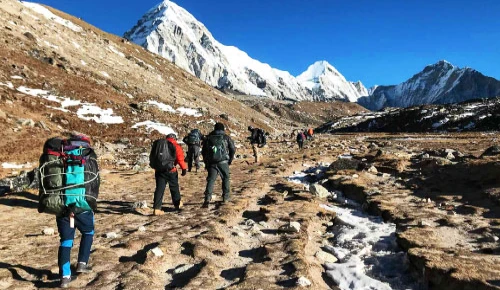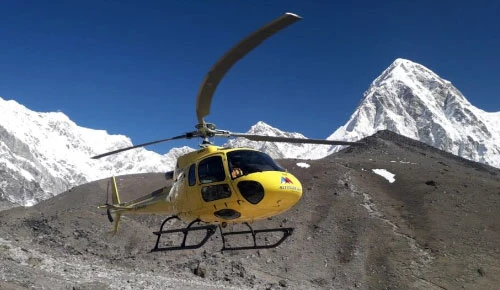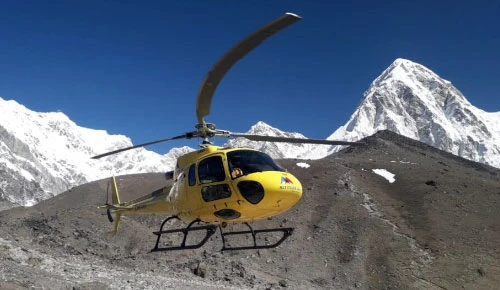Top 10 Difficulties & Surviving Tips of EBC Trek with Heli Return
The Everest Base Camp (EBC) trek is one of the most popular trekking routes in the world. It is also one of the most challenging, with high altitude, difficult terrain, and unpredictable weather conditions. If you are considering doing the Everest base camp trek with heli return, it is important to be aware of the difficulties you may face and how to overcome them.
Table of Contents
Difficulties
Altitude: The trek reaches an altitude of 5,545 meters (18,200 ft). This is a significant challenge for even the fittest people. Altitude sickness can occur at any altitude, but it is more common above 2,500 meters (8,200 ft). Symptoms of altitude sickness include headache, nausea, vomiting, dizziness, and difficulty sleeping.
Distance: The trek is approximately 130 kilometers (81 mi) long. This is a long and challenging trek, even for experienced hikers. The trail is often up and down, and there are several sections that are quite steep.
Terrain: The trek takes you through a variety of terrain, including forests, glaciers, and rocky scree. The trail can be slippery and uneven, and there are some sections that are exposed to heights.
Weather: The weather in the Himalayas can be unpredictable. It is important to be prepared for rain, snow, and high winds. The temperature can also vary greatly from day to night.
Crowds: The trek is a popular route, and it can get crowded, especially during the peak season (March to May and September to November). This can make it difficult to find accommodation and get on the trail.
Food and water: There are a limited number of teahouses and lodges along the trek. It is important to bring your own food and water, or to be prepared to pay high prices for these items.
Hygiene: The hygiene conditions on the trek can be challenging. There are few toilets along the trail, and the water quality can be poor. It is important to bring your own toilet paper and hand sanitizer.
Loneliness: The trek can be a lonely experience. You may be spending a lot of time on your own, especially if you are trekking solo. It is important to be prepared for this and to find ways to stay motivated.
Cost: The trek can be an expensive trip. You will need to factor in the cost of the trek itself, as well as the cost of flights, food, accommodation, and equipment.
Permits: You will need to obtain a number of permits to trek to Everest Base Camp. These include a TIMS card, a Sagarmatha National Park entry permit, and an Everest Base Camp trekking permit.
Surviving Tips
Get in shape: The best way to prepare for the trek is to get in good physical condition. Start training several months before your trek, and make sure to include both cardio and strength training.
Acclimatize: It is important to acclimatize to the altitude before starting the trek. This means spending time at lower altitudes before heading to higher elevations.
Pack light: You will be carrying your backpack on your back for the entire trek, so it is important to pack light. Bring only the essentials, and make sure your backpack is comfortable to wear.
Dress in layers: The weather in the Himalayas can change quickly, so it is important to dress in layers. You will need to be prepared for both hot and cold weather.
Drink plenty of water: It is important to stay hydrated on the trek. Drink plenty of water, even if you don't feel thirsty.
Eat a healthy diet: Eating a healthy diet will give you the energy you need to complete the trek. Make sure to eat plenty of fruits, vegetables, and whole grains.
Get enough sleep: Sleep is essential for recovery, so make sure to get enough sleep each night.
Listen to your body: It is important to listen to your body and take breaks when you need them. Don't push yourself too hard, especially at high altitude.
Be patient: The trek is a challenging trek, so it is important to be patient. Take your time and enjoy the journey.
Hire a guide: If you are a first-time trekker, it is a good idea to hire a guide.
Outlined Itinerary
| Day | Activity | Description |
|---|---|---|
| 1 | Arrival in Kathmandu | Arrive in Kathmandu, the capital of Nepal, and explore the vibrant city or relax at your hotel. |
| 2 | Flight to Lukla (2,840m) and trek to Phakding (2,610m) | Take a scenic flight from Kathmandu to Lukla and begin your trek through the Sagarmatha National Park. Enjoy the beauty of Phakding nestled in the foothills. |
| 3 | Trek from Phakding to Namche Bazaar (3,440m) | Embrace the breathtaking views of the mountains as you ascend to Namche Bazaar, the bustling Sherpa capital of the Khumbu region. |
| 4 | Acclimatization Day in Namche Bazaar (3,440m) | Spend a day adjusting to the higher altitude by visiting the Sagarmatha National Park Museum or hiking to Everest View Hotel for mesmerizing panoramas. |
| 5 | Trek from Namche Bazaar to Tengboche (3,870m) | Continue your journey with stunning vistas of Everest and Lhotse, culminating at Tengboche, renowned for its ancient and grand monastery. |
| 6 | Trek from Tengboche to Dingboche (4,410m) | Immerse yourself in the tranquility of Dingboche, a quiet village with breathtaking mountain views. |
| 7 | Acclimatization Day in Dingboche (4,410m) | Another day for acclimatization allows you to hike to Chhukhung Ri for even more spectacular scenery. |
| 8 | Trek from Dingboche to Lobuche (4,910m) | Take on the demanding climb to Lobuche, a small village offering panoramic views. |
| 9 | Trek from Lobuche to Gorak Shep (5,180m) and visit to Everest Base Camp (5,364m) | Embark on the longest and most challenging day, reaching Gorak Shep and finally standing at the iconic Everest Base Camp. |
| 10 | Summit of Kala Patthar (5,550m), Helicopter Flight Back to Lukla and Returning to Kathmandu by plane | Conquer the summit of Kala Patthar for unparalleled views of Everest before taking a helicopter back to Lukla and flying back to Kathmandu. |
| 11 | Departure Day | Bid farewell to Nepal and carry the memories of your awe-inspiring EBC trek. |
This is what most itinerary routes go through but there can always be some changes. It will give you an idea of the altitude, acclimatization and big picture of the heli return trek.
However, there are some difficulties and challenges that you should be aware of if you are considering doing the EBC trek with a heli return. In this blog, we uncover insights to make informed decisions and enhance your trekking experience.
Altitude: The Silent Adversary
Altitude sickness poses a significant challenge for EBC trekkers, especially those with limited high-altitude experience. The trek ascends rapidly, reaching an elevation of 5,364 metres (17,598 feet) at Gorakshep, the final stop before the base camp. At this altitude, the partial pressure of oxygen is significantly reduced, leading to symptoms like headaches, nausea, vomiting, dizziness, and fatigue.
According to a study published in the "Journal of Wilderness Medicine," the incidence of altitude sickness among EBC trekkers ranges from 20% to 60%.
Your Guide to Preventing, Managing, and Recognizing Altitude Sickness
Altitude sickness, also known as Acute Mountain Sickness (AMS), is a common ailment experienced by trekkers ascending rapidly to high altitudes. While typically mild and self-limiting, it can significantly impact your trek and enjoyment. Here's how to prepare, manage, and recognize early symptoms of altitude sickness:
Early Symptom Recognition
Always be aware of the early symptoms of altitude sickness, which include:
- Headache
- Fatigue
- Dizziness
- Nausea
- Loss of appetite
- Difficulty sleeping
- Shortness of breath
- Increased heart rate
- Swelling of the face, hands, or feet
If you experience any of these symptoms, stop and rest immediately. Consider descending to a lower altitude if symptoms worsen or don't improve after 24–48 hours.Your guide will be holding your back throughout .
Preparation:
- The most effective way to prevent altitude sickness is to allow your body time to acclimatise by ascending slowly and incorporating rest days. Aim for a maximum elevation gain of 300–500 metres per day.
- Drink plenty of water (3–4 litres per day) before, during, and after your trek. Dehydration exacerbates altitude sickness symptoms.
- Maintain a healthy diet rich in carbohydrates, protein, and healthy fats. Avoid excessive alcohol and caffeine, which can dehydrate you.
- Proper rest allows your body to recover from the physical exertion of trekking and acclimatise to the altitude.
- Consult your doctor about preventive medication like Diamox (acetazolamide). This medication helps your body breathe more efficiently and reduces the symptoms of altitude sickness.
Management:
- If you experience moderate-to-severe altitude sickness symptoms, descending to a lower altitude is the most effective treatment. This allows your body to adjust to the lower oxygen levels.
- Take breaks throughout your trek and avoid strenuous activity. Resting allows your body to conserve energy and prioritise acclimatization.
- Continue to drink plenty of fluids to aid in oxygen delivery and combat dehydration.
- Use medication prescribed by your doctor.
Unpredictable Weather Conditions
The Himalayas are renowned for their unpredictable weather patterns. The region experiences all four seasons, and the weather can change drastically within a short period of time. Trekkers may encounter a range of conditions, from hot and sunny days to cold and snowy nights. Rain and fog can also make trekking conditions more challenging, especially on narrow trails and steep inclines.
The Khumbu region, where EBC is located, experiences an average annual rainfall of 1,200 millimetres (47 inches). Snowfall is common during the winter months, especially at higher elevations.So, precise planning is important.Weather data for the Khumbu region indicates a distinct seasonal pattern, with the wettest months being June–September and the coldest months being December–February. Therefore, autumn is widely recommended.
Logistical Challenges
The EBC trek with heli return requires careful planning and coordination. Trekkers need to secure permits, arrange transportation, and book accommodation well in advance. Additionally, the logistics of coordinating helicopter flights can be complex, especially during peak season or in the event of unfavorable weather conditions.
Physical and Mental Endurance
The trek demands physical and mental endurance. The daily treks can last for several hours, covering steep terrain and varying elevations. Trekkers need to be in good physical condition and have a strong sense of determination to overcome the physical challenges of the trek. Mental resilience is also crucial to maintaining motivation and overcoming the inevitable moments of fatigue and self-doubt.
Trekkers should be able to hike for several hours daily at a moderate pace while carrying a backpack. Let's break it down :
Physical:
- Hiking for several hours daily: Trekkers should be able to Hike for 5-7 hours a day at a moderate pace while carrying a backpack.
- Steep terrain: The trek involves traversing varying elevations, with ascents and descents that can be challenging.
- High altitude: Acclimatizing to the high altitude is crucial to avoid altitude sickness, which can cause headaches, nausea, fatigue, and other symptoms.
Mental:
- Motivation and determination: The trek requires mental fortitude to overcome fatigue, self-doubt, and challenging stretches of the journey.
- Mental resilience: Coping with the demands of high altitude, unpredictable weather, and long trekking days requires mental strength and adaptability.
- Positive attitude: Maintaining a positive outlook and focusing on the rewarding aspects of the trek can help trekkers persevere and enjoy the experience.
Risk of Flight Cancellation/Late
One of the main concerns with the Everest heli return trek is the risk of flight cancellations or delays. Due to the unpredictable weather conditions in the Himalayas, helicopter flights can be grounded for safety reasons. This can lead to trekkers being stranded in Lukla or other settlements along the trek, extending their trip by several days or even weeks. In some cases, flights may be completely cancelled, forcing trekkers to retrace their steps back to Kathmandu, which can be a disappointing and physically demanding experience.
Statistics data for Cancellation
According to a study by the Nepal Mountaineering Association (NMA), cancellation and delay rates significantly affect helicopter flights to and from Lukla. The study reveals that approximately 10–15% of helicopter flights face cancellations annually, primarily attributable to adverse weather conditions. In addition to cancellations, delays are even more prevalent, affecting an estimated 30–40% of helicopter flights. These delays can stem from a combination of unpredictable weather patterns and operational challenges.
Spring (March–May) or autumn (September–October) is our recommended season, as fewer cancellations and delays are experienced .
Factors Affecting Flight Cancellations and Delays
- The primary factor affecting helicopter flights is the weather. Fog, low clouds, strong winds, and snow can significantly reduce visibility and make flying hazardous.
- Helicopter flights can also be cancelled or delayed due to technical issues with the aircraft or maintenance requirements.
- Air traffic congestion, particularly during peak season, can lead to flight delays and cancellations.
Risks and Consequences of Flight Cancellations/Delays
- Flight cancellations or delays can significantly extend the duration of the trek, requiring trekkers to make additional arrangements for accommodation and food.
- Extended stays due to flight cancellations can lead to increased costs for accommodation, food, and additional permits.
- Being stranded in Lukla or other high-altitude settlements can take a toll on trekkers' physical and mental well-being, especially if they are ill-prepared for extended stays.
Mitigating the Risk of Flight Cancellations and Delays
- Trekking during the shoulder seasons (March–May and September–October) can reduce the risk of flight cancellations and delays.
- Stay updated on weather forecasts and be prepared to adjust your trekking itinerary if necessary.
- Book your trip well in advance to secure your preferred schedule and increase your chances of getting a flight. Booking through credible companies like us, Nepal Trek Adventure minimises the risk of flight problems.
- Consider purchasing travel insurance that covers flight cancellations and delays to offset any additional costs.
Alternative Return Options for the EBC Trek: Beyond the Helicopter
While the helicopter return offers a convenient and time-saving option for completing the Everest Base Camp, some trekkers may be concerned about potential flight cancellations due to weather or other unforeseen circumstances. Fortunately, several alternative return options can provide a safe and enjoyable experience.
Trekking Back Down
- Trekking back allows you to experience the diverse landscapes and villages at a slower pace, allowing you to appreciate the beauty of the Himalayas more fully.
- Descending gradually provides additional time for your body to adjust to lower altitudes, minimizing the risk of altitude sickness.
- This option requires a higher level of physical fitness and endurance, as you need to cover the same distance twice.
- Consider adding several days to your itinerary to account for the additional trekking time.
Ramechhap Route: A Backup for Cancelled Helicopter Flights
While the helicopter return offers a convenient and time-saving option for the EBC trek, flight cancellations due to weather or other unforeseen circumstances can occur. In such scenarios, the Ramechap route provides a valuable backup option, allowing you to safely and efficiently descend from Lukla without relying on air travel.
Ramechhap Route Overview
The Ramechap route descends from Lukla to Kathmandu via the villages of Phaplu and Beni. This alternative route offers several advantages:
- Trekkers are not affected by potential helicopter cancellations, ensuring a smoother and more predictable descent.
- The route traverses stunning landscapes, including rhododendron forests, rolling hills, and traditional villages, offering a unique perspective on the Himalayas.
- The trek provides opportunities to interact with local communities and experience their rich culture and traditions.
- The route features diverse terrain, including steep descents, gentle valleys, and suspension bridges, offering a challenging and rewarding experience.
Logistics and Planning:
- The Ramechap route is approximately 150 kilometers long and typically takes 5-7 days to complete, depending on your pace and chosen itinerary.
- Numerous guesthouses and lodges are available along the route, offering trekkers comfortable accommodations and meals.
- The Trekkers' Information Management System (TIMS) card and Sagarmatha National Park entrance permit are required for the Ramechap route.
- Hiring a guide or porter is recommended for first-time trekkers or those seeking additional support and assistance.
Benefits of the Ramechhap Route:
- Flexibility: The route allows you to adjust your itinerary based on weather conditions and personal preferences.
- Cost-effective: Compared to the helicopter return, the Ramechap route can be significantly cheaper, making it a budget-friendly option.
- Unique experience: This alternative route provides an opportunity to experience a different side of the Himalayas and discover hidden gems beyond the typical EBC trail.
Cost Considerations:
The cost of the trek varies depending on the time of year, the company you choose to trek with, and the length of your trip. Helicopter flights can be particularly costly, adding a significant expense to the overall cost of the trek.
The cost of the EBC trek with heli return can range from USD 2,000 to USD 5,000 or more, depending on the factors mentioned earlier.
Note: Always check the package for the updated price and its Cost Includes/Excludes.
Frequently Asked Questions (FAQs):
Q1. Is it necessary to buy all the gear, or are rentals available?
Ans: In Nepal, both gear purchase and rentals are available, especially in trekking hubs like Kathmandu. However, personal items like underwear are recommended to bring from your place.
Q2. How noisy is the helicopter, and should I bring ear protection?
Ans: Helicopters can be noisy. Bringing earplugs or noise-canceling headphones is advisable for a more comfortable journey.
Q3. What should I do in case of motion sickness during the helicopter ride?
Ans: If prone to motion sickness, consider appropriate medication. Additionally, sitting near the helicopter's center of gravity may help reduce motion sickness.
Q4. Can I take photos during the helicopter ride, and are there any guidelines?
Ans: Yes, you can take photos. Be considerate of other passengers and avoid interfering with the pilot's line of sight or controls.
Q5. How should I dress for the helicopter ride?
Ans: Dress in warm layers, as helicopter cabins may be cooler than ground temperatures. Ensure you have secured loose items like hats and scarves.
Embrace the Challenge, Reap the Rewards
Despite the challenges, the EBC trek with a heli return offers an unparalleled opportunity to experience the Himalayas' grandeur. Imagine standing at Everest Base Camp, gazing upon the world's tallest peak, and knowing you conquered the challenge with both efficiency and resilience.
Ready to Book Your Adventure?
Don't let the challenges deter you. With careful planning, the right guide, and a spirit of adventure, the Everest base camp trek with helicopter return can be the experience of a lifetime. Contact us today to book your hassle-free package and start planning your ascent to the foot of the world!
Remember, the Himalayas await, and with the right preparation, you can conquer Everest Base Camp and etch your own story in their legend.








